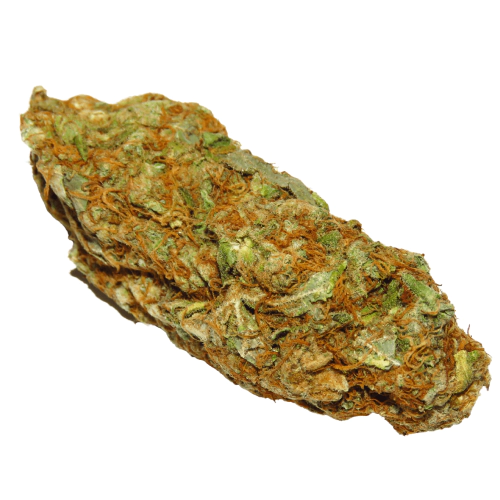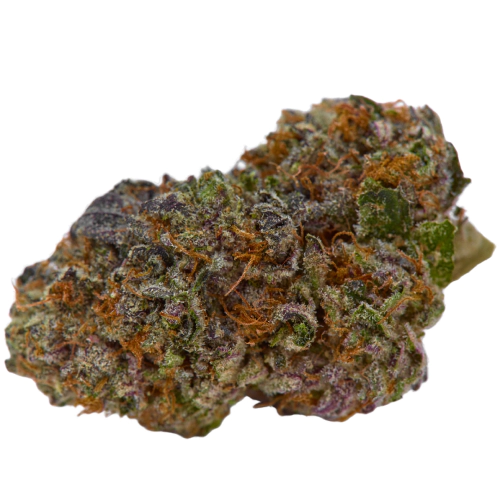Modified Mints
Cannabinoid THC Dominant
THC 17 - 18%
CBD 1.18 - 1.31%
Effect Giggly
Side Effect Dizzy
Flavor Spicyherbal
All About Modified Mints Weed Strain
THC
CBD
Potency
The Modified Mints strain is a slightly Indica-dominant hybrid (60% Indica / 40% Sativa). The weed resulted in crossing the famous GMO and SinMint Cookies strains. If you have tried one or both of its parents, you will be happy to enjoy the perfect mix. The Modified Mints weed has a sweet and spicy taste with pungent menthol undertones due to phellandrene as the prevalent terpene. The effects provided by the Modified Mints marijuana bud are mainly relaxing and soothing, allowing smokers to achieve inner balance and reduce the stresses of the day. The THC concentration in the Modified Mints cannabis bud reaches 17-18%, making it suitable for moderate and experienced consumers.
Alongside THC, there are also other cannabinoids in the Modified Mints strain. They include the following ones:
- CBD 1.18 - 1.31%
- CBC 0.14 - 0.22%
- CBG 0.01 - 0.03%
- CBN 0.31 - 0.32%
- THCV 0.15 - 0.18%
Taste, Aroma, and Terpenes of Weed
As its name implies, the Modified Mints strain packs a sweet and mint-like flavor with pungent spicy and earthy hints. The taste is complemented by spicy nuttiness and touches of floral undertones. The aroma is very similar but features more heavily pungent earthy overtones mixed with spicy herbs and a delicious punch of fresh menthol. The taste and fragrance come from a terpene composition dominated by phellandrene. Other terpenes in the weed include the following ones:
- Carene
- Myrcene
- Camphene
- Limonene
- Bisabolol
Effects and Medical Applications
The Modified Mints strain produces a high that isn't eye-opening, featuring mainly calming effects that can help you kick back and unwind rather than get up and move. Within the first few inhales, you will notice a buzzing physical sense that sets the mind and body apart. The Modified Mints marijuana leaves you feeling like you have a euphoric experience that is giggling in its nature. This buzz quickly swaps with the deep relaxation and sedative effects, allowing you to fall off into a long and peaceful sleep. Combined with its moderate THC concentration, these effects make the Modified Mints cannabis bud a great choice for treating conditions such as:
- Stress
- Insomnia
- Arthritis
- Depression
- Lack of appetite
Some sensitive smokers may experience the following minor side effects:
- Dizzy
- Hunger
- Tingly
- Dry eyes
- Depression
- Hallucination
- Thirst and dry mouth
Modified Mints Growing Tips
The Modified Mints strain produced buds that have tapered and long blue-green spade-shaped nugs and light purple undertones. These buds are also covered in long yellow-orange hairs and a thin coating of tiny white crystal trichomes with purple hints. According to growers, the Modified Mints weed has a flowering window of 55-62 days, while growers are able to pick the yield in 61 days. When cultivating indoors and out, the plant may reach 30-60 inches in height.
Side Effects
Simply let us know how this strain tastes or write a detailed review.
Modified Mints Strain Cannabinoids
| THC | Tetrahydrocannabinol, or THC, is a major cannabis chemical compound. It is a psychoactive element that stimulates dopamine release and induces euphoria or happiness. THC-rich strains may be helpful with such conditions as lack of appetite, chronic pains , etc. It is considered to be the primary active marijuana component. | 17 - 18% |
| CBD | Cannabidiol, or CBD, is a major compound in cannabis, which is non-psychoactive. It is also proved to counteract the side effects of the second major component THC. CBD is widely used for medicinal purposes in rubs, oils and so on. It is helpful in muscle pain cases, may treat arthritis and migraines. Even Greeks used it against pain, while Queen Victoria applied it to get rid of menstrual cramps. | 1.18 - 1.31% |
| CBC | Cannabichromene, or CBC, is a minor cannabinoid, meaning that its quantity in cannabis is quite little. Though it has the same origin as CBD and THC, it is different in functions. Without any psychoactive effects, it is an efficient cannabis compound in combating acne and depression. CBC produces analgesic, antibacterial and anti-inflammatory effects. | 0.14 - 0.22% |
| CBG | Cannabigerol, or CBG, is one of the minor cannabis compounds in adult plants. On the other hand, young ones contain a lot of this antibacterial and anti-inflammatory component. During the growth, CBG is converted into different cannabinoids, mostly THC and CBD. The compound itself increases appetite and decreases eye pressure. | 0.01 - 0.03% |
| CBN | Cannabinol, or CBN, is a trace element in cannabis that is considered to be mildly psychoactive. It appears from oxidation THC, exposed to light and heat. CBN is mostly contained in old cannabis and in traditional hashish. It is effective against insomnia, bacterial infections and appetite loss. | 0.31 - 0.32% |
| THCV | Tetrahydrocannabivarin, or THC-V, is a compound contained in cannabis in trace amounts. Even though it is close to THC molecularly, it is different in effects. This compound may be psychoactive only in large amounts. THC-V reduces blood sugar, controls appetite, stimulates bone growth, etc. African Sativa strains are the richest in THC-V. | 0.15 - 0.18% |
Modified Mints Terpene Profile
| Carene | Carene (also known as Delta-3 carene) is a terpene found in rosemary, lemons, pines, and cedars, offering citrusy and cypress aroma. Studies on mice showed that carene provides anti-inflammatory effects, as well as promotes bone health and chronic pain relief. | 0.12% |
| Myrcene | Myrcene (also known as β-myrcene) is one of the most common terpenes found in cannabis, representing more than 20% of the modern marijuana terpene profile. Myrcene has a distinct earthy, musky flavor, resembling cloves. It is responsible for calming and soothing effects of weed. Myrcene is also found in hops, thyme, mango, lemongrass, guava melon. | 0.08% |
| Camphene | Camphene is terpene common for carrots, pepper, dill, fennel, nutmeg, thyme, as well as other fruits and vegetables. Camphene has a damp, pungent, herbal, minty aroma with pine undertones. In cannabis, mostly found in Indica strains. Camphene causes cooling sensations, having anti-inflammatory, antibiotic, antioxidant, analgesic, and antifungal effects. | 0.1% |
| Limonene | Limonene (also known as d-limonene) is the second most common terpene in nature and the third most common terpene in cannabis. It has a powerful citrus aroma and can be found in all citruses, including lemons, oranges, grapefruits, limes, juniper, etc. Limonene is known to elevate moods and provide anxiety, depression, and stress relief. | 0.18% |
| Bisabolol | Bisabolol (also known as α-Bisabolol or levomenol) is a lesser-known terpene found in cannabis. It contributes to anti-inflammatory, anti-irritant, antioxidant, anti-microbial, and analgesic properties of weed strains containing bisanol. Attentive smokers would be able to catch a nutty, fruity scent with herbal and floral undertones, with a tender trace of coconut. | 0.16% |
| Phellandrene | Phellandrene (also known as alpha- and beta-phellandrene) is one of the rare terpenes found in cannabis with antihyperalgesic and antidepressive properties. Phellandrene contributes to a minty, woody, and mildly citrus aroma in cannabis. Previously confused with limonene and pinene, phellandrene was eventually distinguished as a separate terpene common for eucalyptus. Also, it could be found in mint, dill, black pepper, cinnamon, parsley, pine, and lavender. | 0.35% |
| Total terpenes content | 0.99% |
Growing Info
Similar Strains
THC 15 - 18%
CBD 0.03 - 1.02%
Effect Giggly
Flavor Grape
THC 16 - 18.5%
CBD 0.31 - 0.62%
Effect Euphoric
Flavor Earthy
THC 23 - 24.75%
CBD 0.22 - 0.43%
Effect Happy
Flavor Spicyherbal
THC 9.67 - 7%
CBD 11.05 - 11.4%
Effect Happy
Flavor Tobacco
THC 20.33 - 24.67%
CBD 1.12 - 1.73%
Effect Giggly
Flavor Flowery
THC 21 - 23%
CBD 0.09 - 1.14%
Effect Calm
Flavor Mint
THC 21.5 - 27.5%
CBD 0.25 - 1.15%
Effect Concentrated
Flavor Chestnut








Be the first and share your opinion
Write a Review